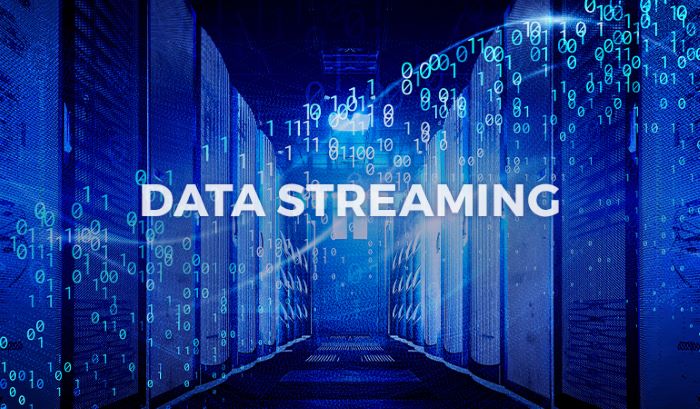
Data streaming is the underlying technology driving our modern world. It is everywhere from video streaming to live analytics, and behind the music we hear on our headphones.
For organizations, the ability to tap into continuous data flows from diverse sources unlocks valuable insights. The more data you can harness in real-time, the better positioned you are to stay ahead in today’s business world.
This article will explain what is data streaming, its details, and top data streaming applications.
What is Data Streaming?
Streaming data, also known as data streaming or event stream processing, is data that is uninterruptedly produced by different sources. You need to process such data incrementally using stream processing methods without having access to all of it. Moreover, the possibility of concept drift in the data should be considered, meaning that the stream properties might change with time.
Streaming is often used when discussing big data generated at high speeds from various sources. Data streaming is a technology that provides content to user devices over the Internet. A key feature of streaming is that users can access the content instantly instead of waiting for it to download.
How Does Data Streaming Work?
Data streaming continuously processes and analyzes data in real-time or near real-time as it is generated. Streaming data emerged as a solution for the problems of batch processing.
In batch processing, data is collected and stored for processing at a later stage. This caused high rates of latency as data is processed only after being collected for a certain period.
So, data streaming processes data continuously as it is generated. Here is how:
Data Generation
Data is created by various sources, such as:
- IoT sensors
- Applications
- Social media
- Transaction systems
- Server Logs
These sources emit continuous streams of data in small chunks rather than large batches.
Ingestion
The generated data streams are ingested into a streaming platform or framework, such as:
- Apache Kafka
- Apache Pulsar
- Amazon Kinesis
Stream Process
Stream processing engines process the incoming data in real-time. This step involves operations such as filtering, aggregating, and transforming the raw data to extract meaningful insights.
Data Storage
Processed or raw data may be stored in a database, data lake, or other storage systems for further analysis or archival purposes.
Data Analysis
The processed data is analyzed to derive insights or power real-time applications.
Delivery and Visualizations
The processed data is delivered to end-users or systems in real time. This could be in the form of dashboards, APIs, or other applications that consume the data.
Data Streams and Data Lakes
The rise of big data is compelling companies to double down on storage costs, which, in turn, is leading to an interest in data streams and data integration. A data lake refers to keeping vast amounts of structured and unstructured data in a centralized repository. You can easily access this repository to extract and pull the necessary data whenever needed.
The difference between a data stream and a data lake is in terms of the speed and nature of analysis—the former performs real-time analysis on streaming data, while the latter requires you to store the data before analyzing it.
Streaming is also the continuous broadcasting of audio-visual files from a server to a user. In other words, streaming happens when consumers listen to podcasts or watch TV on devices connected to the internet. When streaming, the media file played on the client device is stored remotely and transmitted a few seconds at a time over the internet.
The fact that streaming takes place in real-time makes it more efficient than downloading media files – the latter naturally takes more time; thus, it is the less preferred option. For example, when you download a video file, you have to wait for the downloading to complete before playing it. However, when you stream a video, your browser plays it instantly without copying or saving it on your device. Whatever information you stream on your browser is not stored locally on your device; instead, it loads and plays incrementally.
Benefits of Data Streaming
Data streaming is advantageous in scenarios where real-time insights and responsiveness are critical. Here are the key advantages:
- Real-Time Insights allows organizations to process and analyze data as it is generated for immediate actions.
- Better Customer Experience through delivering personalized and responsive user experiences based on live data.
- Less Storage Costs as data is processed and analyzed in real-time eliminating the need for expensive data warehouses.
- Flexibility to handle large volumes of continuous data from diverse sources to meet organizational needs.
- Faster Time by reducing the delay between data generation and actionable insights, leading to quicker outcomes.
Limitations of Data Streaming
Here the key challenges that limit the prospects of data streaming:
- High Complexity requires expertise in setting up streaming platforms. This makes implementing real-time data streaming architecture complex compared to batch processing.
- Data Consistency and Quality is difficult to maintain since data often comes from diverse sources, increasing the risk of incomplete or erroneous data.
- Lack of Reliability means streaming systems sometimes fail during hardware failures, network interruptions, or unexpected data surges.
- Data Security can be risky as data comes in real-time and usually is disposed after processing.
- Cost Managment can become overbearing as real-time systems demand high compute power, storage, and network bandwidth.
Industries using Data Streaming
Data streaming has become a critical business tool in today’s tech-enabled world. It is in a broad range of industries, including the following:
- Finance: It allows you to track and monitor changes in the stock market in real time. It also calculates value-at-risk and dynamically adjusts your portfolios depending on stock price movements.
- Real estate: Websites can monitor a subset of data from users’ mobile devices to give them recommendations to visit specific properties based on their geographical location.
- Gaming: Online gaming companies can gather streaming data related to player-game interactions and feed it into their platform to improve user experience. Players can also livestream their gameplay.
- E-commerce/Marketing: Data streaming can potentially provide all the clickstream records from its online presence. It enriches the data through users’ demographic information. It also helps you optimize content placement on the site, thus enabling you to deliver relevant content and improving the overall customer experience and satisfaction.
- Home Entertainment: Streaming is also used in the home entertainment industry as many companies provide different smart devices like Chromecast (Google), Roku TV, FireTV (Amazon), LG TV, and Samsung TV. Users can use these devices to stream any type of data from their smartphones, tablets, or laptops using a Wi-Fi connection. It includes streaming photos and videos and sharing a screen on a bigger screen.
- Audio/Video Calling – Data streaming is also used in live audio/video chat applications, as live data is streamed directly through the internet.
Top Data Streaming Applications
- Netflix: Netflix is a very popular subscription-based streaming service that allows its subscribers to watch movies and TV shows sans commercials on a device connected to the internet. Not only this, but you can also download movies and shows on your device to enjoy watching them when you’re not connected to the internet.
- Microsoft Teams: Another famous application where members can share content, make live audio/video calls, chat, and share their screens, irrespective of the device they are using.
- Google Chromecast: Google Chromecast is a streaming media adapter developed by Google that lets users play online content, such as videos and music, on digital television. The adapter is a dongle that plugs into the TV’s HDMI port; a cable connects to a USB port to power the device. If you’re using Google Chrome on your computer, you can cast any webpage you want onto the TV and enjoy a higher resolution.
It has an Android-based operating system where you can install any application, i.e., YouTube, Netflix, and many more. Users can also play games on a mobile and cast them on the TV screen. If you have no projector and you need to give a presentation, you can use Chromecast to share your slides. - Spotify: Spotify is a popular music streaming app that streams music to users while offering real-time curated playlists. Spotify continuously streams audio content to users. It also analyzes listening habits in real-time to recommend songs and generate playlists.
- Uber: Uber provides ride-hailing services by matching riders with drivers and optimizes routes in real time. It tracks vehicle locations and traffic conditions, provides real-time updates on fare adjustments, and shows ride progress.
How can Xavor help?
Today, everybody owns a smartphone and a smart TV. However, few applications allow customers to stream their mobile data on a TV screen.
Xavor can create a customized streaming application that is secure and lets you play whatever kind of data you want on a smart TV without the risk of data leakage. We also offer custom application development services with any functionality you like for Google Chromecast. We strive to build innovative mobile apps and design proper systems for our clients to help them achieve their business goals.
Our mobile app development services include:
- UI/UX Design Services
- App Development (Android & iOS, Smart TV)
- Integration of subscription payments
- Automated QA & Testing Services
- Uploading & Managing Apps on the App Store
- Enterprise iOS App Store Management
- Maintenance & Support
Contact us at [email protected] for further information.
